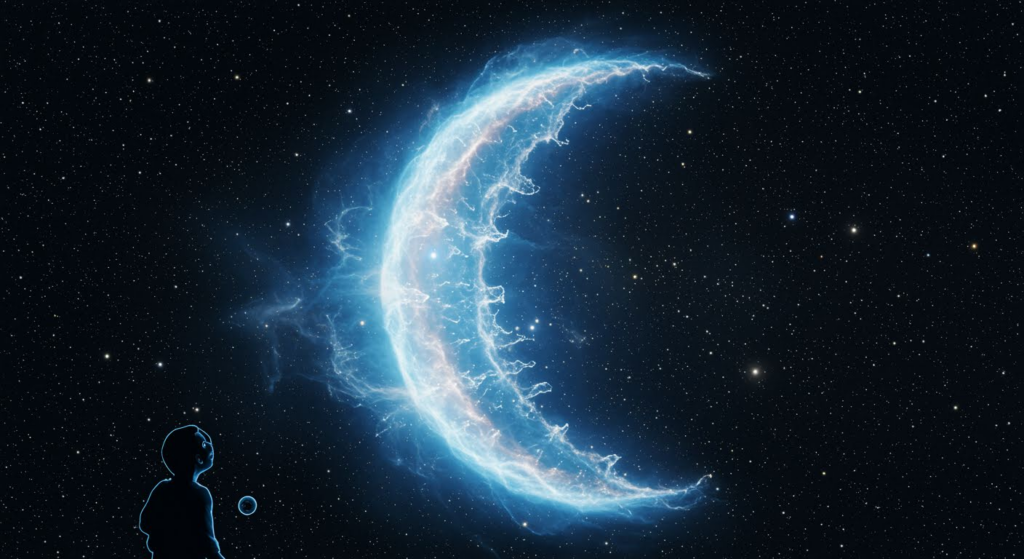
Massive Hydrogen Blob Discovery Near Solar System Reveals Scientific Breakthrough
Astronomers Make Groundbreaking Discovery of the Eos Molecular Cloud Near Our Solar System
Imagine peering into the night sky and uncovering a massive structure that’s been hiding in plain sight for eons. That’s exactly what happened when astronomers spotted the Eos molecular cloud, a vast hydrogen blob just 300 light-years away from us. This discovery, announced on April 28, 2025, marks a pivotal moment in astronomy, offering fresh insights into the interstellar medium and the birth of stars. Have you ever thought about how something so enormous could remain undetected until now?
The Eos molecular cloud isn’t just any cosmic curiosity; it’s a crescent-shaped giant composed mainly of molecular hydrogen, positioned at the edge of the Local Bubble that surrounds our solar system. By directly observing its far-ultraviolet emissions, researchers have unlocked a new way to study these elusive formations. This breakthrough could reshape our knowledge of how stars and planets come to be, making the Eos molecular cloud a key player in ongoing space exploration.
What sets this find apart is its sheer scale—spanning about 40 moons across the sky and boasting a mass 3,400 times that of the Sun. It’s a reminder that even in our galactic backyard, surprises abound. Scientists are buzzing because this detection method, focusing on molecular hydrogen’s fluorescence, opens doors to spotting more Eos molecular cloud-like structures across the universe.
Exploring the Eos Molecular Cloud: What Makes It So Remarkable
The Eos molecular cloud is essentially a stellar nursery in disguise, filled with the raw materials for creating new stars and planets. Despite its proximity, it stayed invisible because it only reveals itself in the far-ultraviolet spectrum, which demands specialized tools to observe. This cloud glows subtly through hydrogen fluorescence, turning what was once a mystery into a tangible piece of our cosmic puzzle.
Why is the Eos molecular cloud such a big deal? It provides a rare up-close look at the processes that fuel star formation, right in our neighborhood. Researchers estimate it contains enough gas and dust to form multiple solar systems, offering a front-row seat to galactic evolution. If you’re fascinated by space, think of it as a living laboratory that could help answer questions about our own origins.
Buried in the interstellar medium, this hydrogen blob challenges our previous assumptions about what’s out there. Its crescent shape and position suggest it’s influenced by nearby stellar winds and radiation, painting a dynamic picture of constant change. The Eos molecular cloud’s discovery invites us to reconsider how we map and understand the spaces between stars.
Revolutionary Detection Techniques Behind the Eos Molecular Cloud Find
Spotting the Eos molecular cloud required a fresh approach, moving beyond traditional methods that relied on indirect signs like radio waves. Instead, astronomers turned to direct observations of far-ultraviolet emissions from molecular hydrogen, a game-changer in the field. Dr. Blakesley Burkhart from Rutgers University led the charge, publishing her findings in Nature Astronomy and highlighting how this technique could transform future searches.
“This is the first time we’ve pinpointed a molecular cloud by its glowing hydrogen molecules,” Dr. Burkhart noted, emphasizing the innovation. By focusing on this specific emission, the team bypassed common obstacles, such as atmospheric interference, which often blocks these signals from Earth-based telescopes. It’s a technique that could uncover more Eos molecular cloud relatives hiding in plain sight.
This method isn’t just about one discovery; it’s about building a toolkit for the future. For instance, what if we applied it to distant galaxies? That could reveal hidden patterns in star formation processes, making the Eos molecular cloud a blueprint for broader cosmic mapping. If you’re into tech, consider how advancements like this echo the evolution of tools in everyday innovation—pushing boundaries with smarter detection.
Scientific Implications: How the Eos Molecular Cloud Advances Our Knowledge
The Eos molecular cloud’s presence so close to us is a goldmine for understanding the interstellar medium’s role in shaping galaxies. These clouds act as the building blocks for stars, pulling together gas and dust to create new celestial bodies. With the Eos molecular cloud within reach, scientists can study these mechanisms in unprecedented detail, almost like examining a prototype in a lab.
Insights into Star Formation from the Eos Molecular Cloud
Star formation is a complex dance, and the Eos molecular cloud gives us a rare view of it unfolding. Inside, gravity pulls material together, eventually igniting nuclear fusion to birth new stars. Dr. Burkhart pointed out that observing the Eos molecular cloud lets us track these steps directly, helping us measure how gas clouds form and break apart over time.
Have you wondered how our Sun came to be? The Eos molecular cloud offers clues, showing the same processes at work nearby. It’s not just theoretical; it’s practical knowledge that could inform models of planetary system development. By studying this cloud, we might even predict where new stars will emerge next in our galaxy.
Broader Impacts on the Interstellar Medium via the Eos Molecular Cloud
The interstellar medium is the glue holding galaxies together, and the Eos molecular cloud highlights its dynamic nature. It interacts with cosmic rays and stellar radiation, influencing everything from gas distribution to galactic evolution. Researchers predict the Eos molecular cloud will dissipate in about 6 million years, giving us a timely window to observe its full life cycle.
This evaporation process is key to understanding how matter recycles in space, feeding new generations of stars. For example, as the Eos molecular cloud breaks down, its materials could seed future formations elsewhere. It’s a cycle that underscores the interconnectedness of the universe, much like how ecosystems on Earth rely on renewal.
Future Research and the Legacy of the Eos Molecular Cloud
With the Eos molecular cloud in the spotlight, scientists are gearing up for deeper investigations. NASA’s James Webb Space Telescope is already scanning for similar structures, building on the techniques that revealed this hydrogen blob. This could lead to a comprehensive map of molecular hydrogen in our galaxy, transforming our view of the cosmos.
Comparing the Eos Molecular Cloud with Other Discoveries
Recent missions like New Horizons have studied nearby space through Lyman-alpha emissions, revealing a brighter-than-expected background that hints at hydrogen distributions. Unlike the Eos molecular cloud’s clear detection, those findings didn’t confirm a “hydrogen wall,” showing how observations evolve. This contrast keeps the Eos molecular cloud at the forefront of interstellar research.
It’s exciting to see how these pieces fit together. For instance, while New Horizons focused on atomic hydrogen, the Eos molecular cloud emphasizes molecular forms, offering a fuller picture. If you’re following space news, this synergy could spark even bigger breakthroughs in the years ahead.
Safety Considerations and the Eos Molecular Cloud’s Role in Our Cosmic Neighborhood
Don’t worry—despite its size, the Eos molecular cloud poses no threat to Earth. It’s safely tucked at the Local Bubble’s edge, a remnant of ancient supernovas that created our relatively empty surroundings. This positioning makes it an ideal subject for study rather than a cause for alarm.
In fact, its nearness enhances our ability to learn about cosmic events without venturing far. Think of it as a neighbor we can observe closely, providing data on how stellar explosions shape space over millions of years. For safety enthusiasts, it’s a reassuring example of how science turns potential unknowns into opportunities.
Technical Breakdown of the Eos Molecular Cloud Discovery
Detecting the Eos molecular cloud involved space-based instruments tuned to far-ultraviolet wavelengths, which Earth’s atmosphere blocks. This setup, detailed in the Nature Astronomy paper, showcases the need for advanced observatories. Here’s a quick overview: the cloud is about 300 light-years away, crescent-shaped, and massive enough to span 40 moons in the sky.
Key Physical Traits of the Eos Molecular Cloud
Let’s break it down simply:
- Distance: Roughly 300 light-years from Earth.
- Shape: Crescent, like a cosmic arc.
- Size: Visible as about 40 moons wide.
- Mass: Around 3,400 times the Sun’s mass.
- Location: Edge of the Local Bubble.
- Lifespan: Estimated 6 million years before it fades.
These details, drawn from rigorous analysis, make the Eos molecular cloud a benchmark for future studies. Strong emphasis on precision here ensures we’re building accurate models of interstellar dynamics.
The Bigger Picture: Eos Molecular Cloud in Galactic Context
The Eos molecular cloud fits into a larger story of galactic mapping and evolution. As star-forming hubs, these clouds are crucial for understanding how galaxies grow and change. By refining detection methods, we’re piecing together a more detailed cosmic map, with the Eos molecular cloud as a prime example.
This discovery could influence fields beyond astronomy, like astrophysics or even exoplanet research. For instance, if similar clouds are common, it might hint at more habitable worlds forming nearby. It’s a interconnected web that keeps expanding our horizons.
Wrapping Up: Why the Eos Molecular Cloud Matters Now
In essence, the Eos molecular cloud represents a turning point, blending cutting-edge tech with profound scientific questions. It’s not just a hydrogen blob; it’s a gateway to exploring star formation and the universe’s hidden layers. As we continue to study it, who knows what else we’ll uncover in our cosmic neighborhood?
If this sparks your curiosity, why not dive deeper into related topics or share your thoughts in the comments below? We’re all in this together, learning about the wonders of space, so feel free to explore more on NASA’s site or subscribe for updates. What are your thoughts on discoveries like the Eos molecular cloud—could they change how we see our place in the universe?
References
1. Burkhart, B. (2025). Vast Molecular Cloud Long Invisible, Discovered Near Solar System. Rutgers University. Link
2. NYU News. (2025). Long-Invisible Molecular Cloud Discovered Near Our Solar System. Link
3. Labroots. (2025). Massive Molecular Hydrogen Cloud Discovered Near Solar System. Link
4. Lifeboat Foundation. (2025). A New Molecular Hydrogen Cloud Discovered Near Solar System. Link
5. ScienceDaily. (2025). New Horizons Study on Galactic Region. Link
Note: Additional sources like Cryogenics Society and Energy.gov were reviewed but not directly cited in the main content.
Eos molecular cloud, hydrogen blob discovery, interstellar medium, star formation, molecular hydrogen detection, Local Bubble, ultraviolet emission, astronomical breakthrough, galactic evolution, space research







